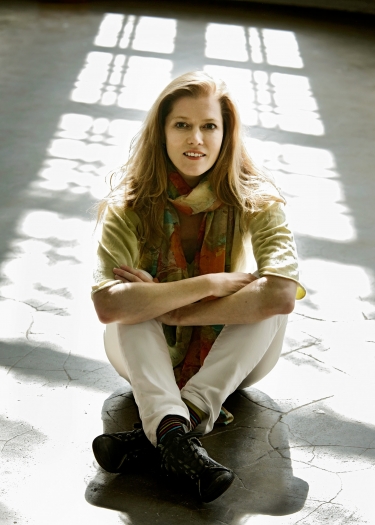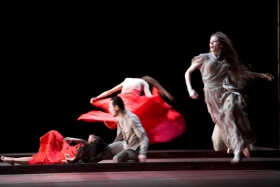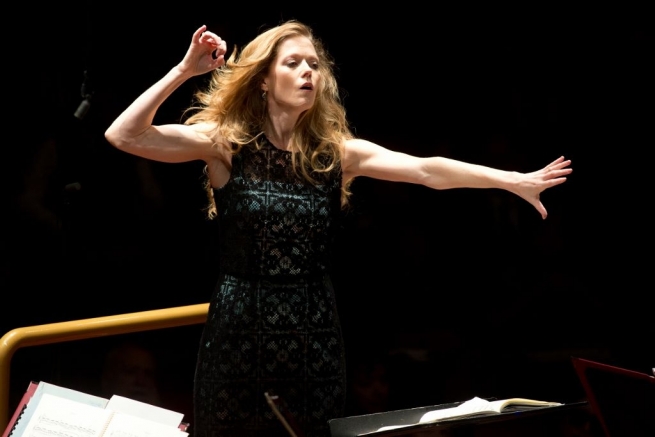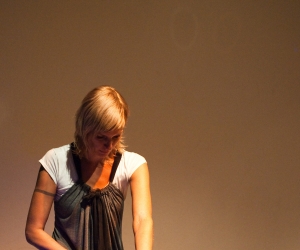“An absolute stroke of luck for opera” is just one of the countless accolades Canadian-born, Amsterdam-based soprano Barbara Hannigan has received for her performances of both classical and contemporary music. Composers and musicians she has worked with are unanimous in their praise. She has premiered a large number of major works, among them operas with roles written especially with her in mind, such as Written on Skin by George Benjamin and Matsukaze by Toshio Hosokawa. Hannigan travels all over the world to perform and do workshops. A few years ago she began conducting, and her singular approach to that art has so thrilled audiences, fellow musicians, and critics that an exciting new creative path has opened up for this very busy artist.
Hannigan has come a long way since moving from Waverley, Nova Scotia, where she was born, to Toronto to study music. “My career has been a real magical mystery tour,” she says. “I don’t come from a sophisticated background. All my life I just loved music. When I went to Toronto to study I knew nothing much about classical music. It was there that I heard both Mahler and Ligeti for the first time. For me, there was no core repertoire or fringe, I was just curious. I still am. I don’t make decisions on what is good or bad other than through what I hear. In Toronto I hooked up with Continuum and Arraymusic, dived into jazz, also performed much old music. I was constantly exploring my voice. I am now basically still doing what I did in my twenties, only in bigger spaces.”
After settling in Amsterdam fifteen years ago, Hannigan landed one of her first major roles, in Louis Andriessen’s opera Writing to Vermeer, which she performed with the Asko|Schönberg ensemble. Reinbert de Leeuw, the ensemble’s conductor, recalls their first encounter: “Louis told me that he wanted Barbara as the first soprano. When she sang her first notes in the audition I was blown off my feet. She has this amazingly beautiful voice. And on top of that she is perceptive, intelligent, and intuitive. She uses all these qualities to reach the core of what lies hidden in music.
“She is one of the few who can sing Webern’s vocal music, and the Gepopo character in Ligeti’s opera Le Grand Macabre. Even Ligeti himself, who was very critical concerning performances of his music, agreed with that. In the whole world there are maybe three sopranos who are up to performing that role.”
Many of the opera characters Hannigan has originated are complex women. Matsukaze, which is based on a fifteenth-century Noh drama by Japanese playwright Zeami, tells the story of two ghost sisters who cannot relinquish their yearning for a handsome nobleman who briefly stayed in their village. (This opera reveals another side of Hannigan’s performance skills, as she joins the ballet in various dances.) In George Benjamin’s contemporary opera Written on Skin, Hannigan portrays Agnès, the uneducated, teenage wife of a wealthy twelfth-century landowner who regards her as his property. The landowner commissions an illuminated book about his life and deeds from an accomplished young artist. Agnès taunts the boy, but when she sees his drawing of her—which depicts her as filled with desire—the boundaries of convention break, and they make love. The boy describes their love on a secret page in the book; Agnès, however, wants her husband to find out about it, so he will know that she is in control of her destiny.
“While in residence at the 2008 Lucerne Festival, I heard Barbara sing a three-minute unaccompanied monody in the huge space of the main orchestral concert hall, and within a few seconds I knew that I had found my soprano for Written on Skin,” relates Benjamin, who worked with each of the five original cast members of Written on Skin while composing the opera. “I accompanied her [Hannigan] in lieder, took notes, and then designed the part of Agnès in the opera to fit her talents. I didn’t employ everything I discovered during our sessions together; for example, her hyper-virtuosic ability in the highest register wasn’t suitable for Agnès. But I most certainly exploited the wondrous floating sound of her middle tessitura and its ability to fuse with orchestral instruments, as I did her fearless ability to leap across the widest intervals. I virtually omitted a certain E flat (her least favourite pitch) in her role, and saved up her mesmerizing high G sharp (unambiguously her favourite note) for special moments. She has inhabited her role in Written on Skin, from its very first performance in Aix, with astounding imagination and intensity.”
Hannigan’s repertoire is not exclusively contemporary. She also sings Mozart arias and solo parts in Bach cantatas. “The choices that I make may seem funny or whimsical,” she notes. “Bottom line is that I feel physically repulsed if I have to sing something I don’t like, similar to eating food that I am allergic to. This isn’t a matter of style or period. Donna Anna in Mozart’s Don Giovanni and the title role in Debussy’s Pelléas et Mélisande have always been on my wish list. Just like [the contemporary roles of] Agnès and Lulu, they carry a dark mystery inside, a secret that lies hidden in the shadows, as in a chiaroscuro. The balance between the different shades in these characters defines the architecture of the music. It is like a building with different rooms: I have to get an overall feel of what kind of building it is, to know whether I want to be there.”
The composers she likes—Henri Dutilleux, Pierre Boulez, Benjamin, Ligeti, to name just a few—may be hugely different, but they all are original voices that combine intellectual ideas and emotion in their music. “I pursue what is interesting for me,” Hannigan continues. “That can be a residency at a traditional, mainstream event like the Lucerne Festival, which I did in the summer of 2014. But I have an obligation to sing contemporary music. I understand it. I love it. I am passionate about it. I don’t follow tradition—I tell that to the composers I work with, and that in doing so we can free each other, and I can more easily get to the core of their music.”
Hannigan collaborated with Danish composer Hans Abrahamsen on his song cycle let me tell you, for soprano and orchestra. The work, which premiered in 2013, is based on Welsh author and musicologist Paul Griffiths’ short novel of the same name, which is a monologue of Ophelia using only the words Shakespeare allots to her in Hamlet. “Ophelia is almost a shadow: she gets manipulated by everyone around her,” says Abrahamsen. “Paul has given her a voice of her own. He has created a beautiful text full of meaning out of her limited vocabulary. He has her say, ‘Let me tell you how it was. I know I can do this . . . My words may be poor but they will have to do. There was a time when I could not do this. I remember that time.’ It refers to the limitations in the text itself, but also to the subordinate position of women in the past.
“It was intended as a composition for Barbara, who asked me to write it,” Abrahamsen continues. “We met some eight years ago in Amsterdam when I was making a transcription of Schönberg’s Vier Lieder for the Asko|Schönberg. She had heard my composition Schnee, which is connected to the novel, because it ends with Ophelia walking out into falling snow. I had had little experience with writing for voice up until then, but Barbara initiated me [right down to] the nuts and bolts—the relation between registers, how they sound best with vowels and consonants, how she could come in softly on a very high note, how she can put on different colours, her limited use of vibrato.
“She can make her voice sound as dense as myriads of snowflakes. She can make her voice thaw from a frosty timbre to intense warmth. She can nail fragility and uncertainty. I had all of this in mind when I started to write. In the first section of the work, she looks back, singing about memory, about a time when there was no time, and about the relation between time and music. The second section is a love song, in which she compares her love with the sun that can both warm her and burn her. In the third section, she walks out into the snow, losing her way as she tries to follow the snowflakes. The orchestra is a huge landscape full of colours that Barbara moves around in; it supports her, at one point almost overwhelms her, and finally leads her on in sparkling sounds.”
The spring of 2009 marked a turning point in Hannigan’s career, when René Bosc (who oversees the programming of new music at Radio France) told Hannigan that she should consider taking up conducting. The suggestion made perfect sense, because when Hannigan sings, she uses her arms, hands, and posture in gestures that seem to be lifting the music she is performing out of her into the open.
“I had never thought about it before, but something in me wanted to pursue that,” she recalls. “Also, because age sets limits to the range and the flexibility of your voice, it’s good to have other options. Performances of Ligeti’s Mysteries of the Macabre and Stravinsky’s Renard were set up in 2011 in the Châtelet Theatre in Paris. René Bosc was taking a huge risk. It could well have been the first and the last time. I felt a deep emotion going on stage, quite different from when I would sing. I knew it was going to change my life. The next day the phone started ringing, and it just didn’t stop. One orchestra after another asked if I could conduct programs for them.
“Conducting comes from my own singing. I don’t use my hands so much, but I give cues with my shoulder, with my head, with the way I lean. Apparently, it is clear and easy to follow. There is this somewhat childish component of being a solo performer, in that you can fall apart and build yourself up again. As a conductor, I want to give that to the players. The responsibility is different. I encourage them to take the risks, then I can do the falling apart and rebuilding with them.”
Violinist Michiel Commandeur of the Mahler Chamber Orchestra, one of the ensembles Hannigan has worked with as a conductor and singer, elaborates on Hannigan’s intuitive style. “The combination of conducting and singing is extraordinary—audiences are enraptured by it,” he says. “It is interesting to her, as well. She is quite ambitious, developing all the time as she builds up experience. The fact that she didn’t follow a formal training [in conducting] doesn’t limit what she can do. In Mysteries of the Macabre she beats incredibly complex times. Barbara evidently enjoys that challenge. Part of the fun is that she uses colourful metaphors rather than technical terms to achieve a certain sound. Instead of asking us to play flautando, she asks us to play like a breeze rustling through leaves.
“She is one of us. She came out of being a musician herself, and that is how she approaches us. It is as if she was sitting by the side and just on the spur of the moment jumped to stand before us. It is all very amicable and social. There is no hierarchy, she is open to our suggestions. And she is incredibly driven: she works at a tremendous pace, throws herself into it with all her being—heart and soul.”
Commandeur fondly remembers a moment during Hannigan’s residency at Lucerne, when she was asked to step in for a conductor who was held up in traffic. “The hall was filled to capacity, and Barbara came over immediately, and took out the score of Ligeti’s Concerto Românesc, which we had performed with her a few days before,” the violinist recalls. “It was a performance off the cuff, totally unpremeditated. If she wants to do something, she just does it, not thinking twice about fame or money. She is by profession a soloist, but she is a team player by nature. We love to go along with her, because we love her as a musician.”
FYI:
Barbara Hannigan won the 2018 Grammy Award for Best Classical Solo Vocal Album for
Crazy Girl Crazy.
Top photo of Barbara Hannigan by Heikki Tuuli. Photo of Hannigan and dancers in Toshio Hosokawa's opera Matsukaze by B. Uhlig. Bottom photo by Musacchio and Ianniello (c).





